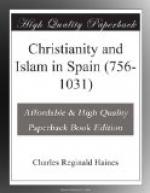[1] Epilandus, Letter to Migetius.
Migne, xcviii. p. 859. See
Neander, v. 216 ff. n.
Enhueber, “Dissert,” secs. 29, 33, apud
Migne, vol. ci.
[2] See Adrian’s Letter to Egila.
[3] Acts xv. 19, 29. See, however, Epist. to Timothy, i. 3.
[4] St Matt. xv. 11.
[5] Titus i. 15.
[6] See also letter to Alcuin, and Felix’s answer to Alcuin’s first book, where he gives us his idea of a Catholic church founded on our Lord Christ (and not on the pope), ... which Catholic church may even consist of few members. Neander, v. 230.
Had the Arab domination embraced the whole of Spain, and continued to be established over it, Spain could never have become the priest-ridden country which it now is; but the gradual advance of the Christian arms in the North brought in its train a more and more complete subserviency to the pope.
As the kings of Castile and Leon gradually won back towns and provinces from the Arabs, some difference was observed to exist between the religious usages of the newly freed Christians and of those who had set them free. This was specially apparent in the old Gothic liturgy, which the Muzarabic Christians had used all along, and were still using, whereas the Christians of Leon and the Asturias had imported a newer recension from Rome.
Rumours of these discrepancies in religious ritual reached Rome, and accordingly a legate,[1] named Zanclus, was sent to Spain in 925 from John X. to inquire into matters of religion, and particularly into the ceremony of the mass, the opinion being prevalent at Rome that the mass was incorrectly performed according to the Gothic liturgy, and that false doctrines were taught. However, Zanclus found that the divergence was not sufficiently wide to warrant the suppression of the ancient ritual. It may be that the power of the Roman Church was not established so securely as to admit of an interference so unpalatable to the ancient church. She was content to bide her time; for such a standing witness to the primitive usage[2] of the Church against the innovations of the Roman See could not long be allowed to continue. Accordingly, we find that very soon after the fall of Toledo in 1085, the question of the old Gothic liturgy came up for discussion again. The Gothic and the Roman books were subjected, after the absurd fashion of the times, to two ordeals—by water and by fire; but in spite of the fact that the Gothic liturgy, thanks to its greater solidity and stronger binding, resisted both those elements incomparably better than its younger rival, and so, if the ordeal went for anything, should have been hailed victorious, the old native liturgy was partially suppressed at the bidding of the pope, and by the consent of the Spanish king Alfonso VI. of Leon,[3] and Sancho IV. of Aragon. Yet the Muzarabic Christians were loath to give up their customary liturgy, and it remained in use in several churches of Toledo till late in the fifteenth century.




